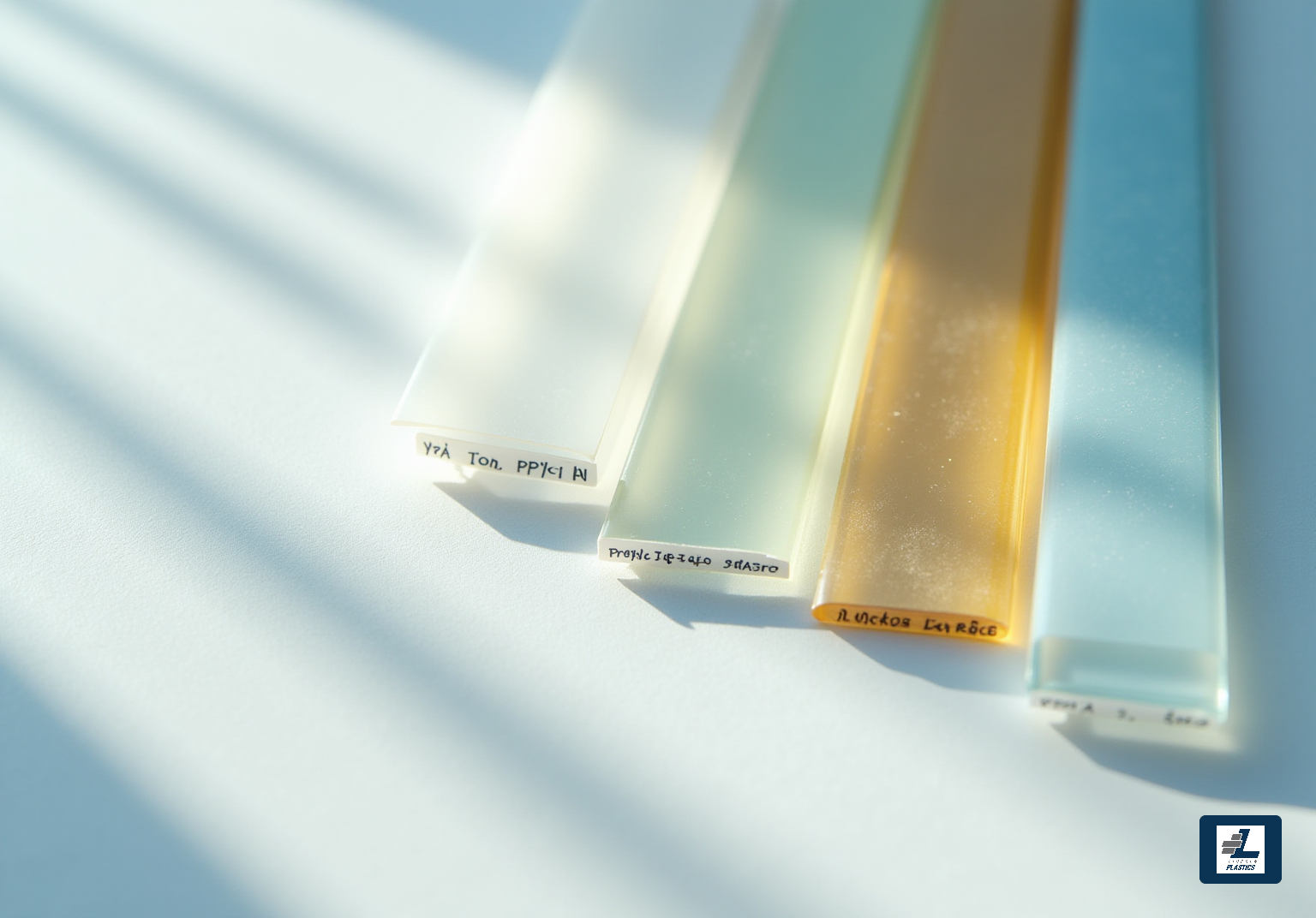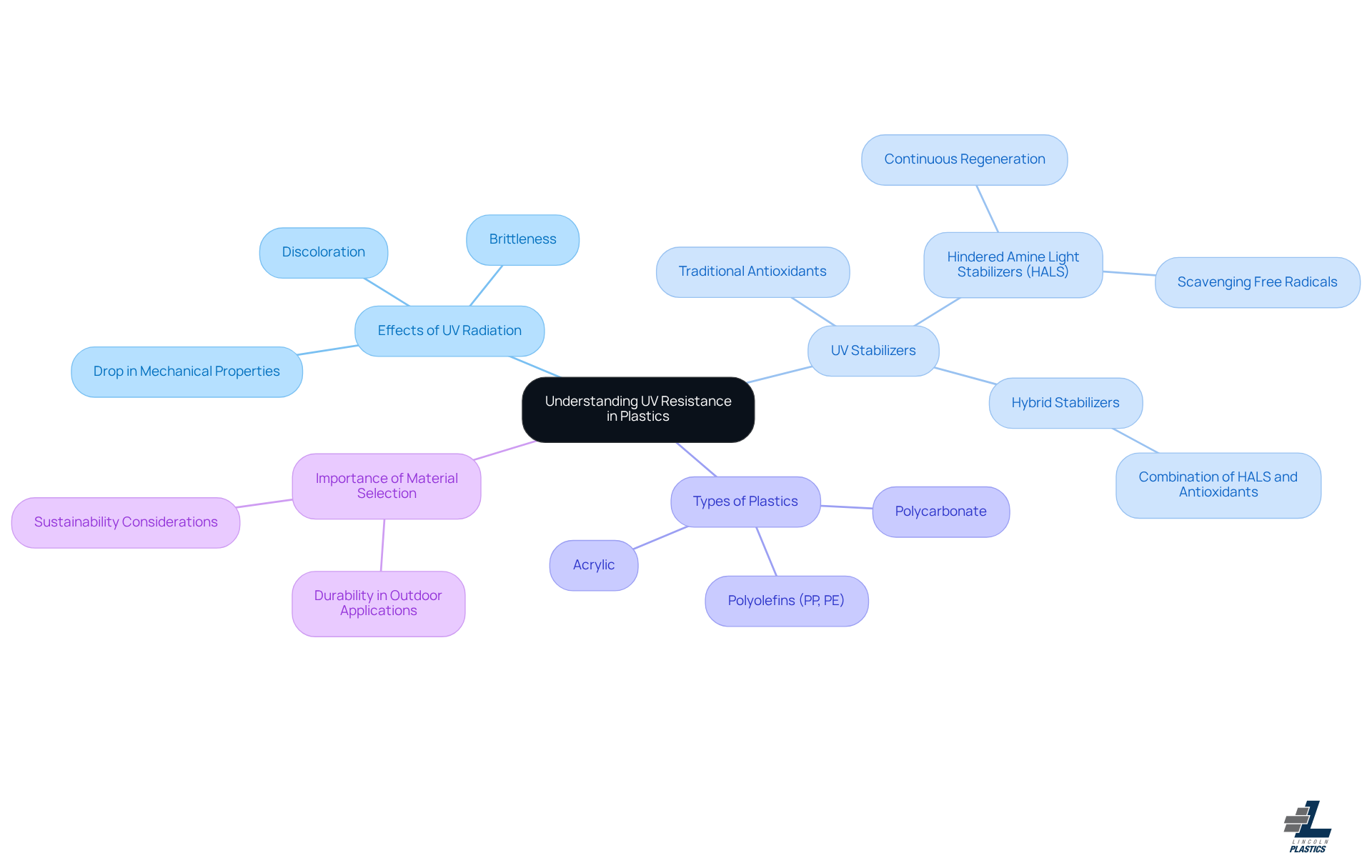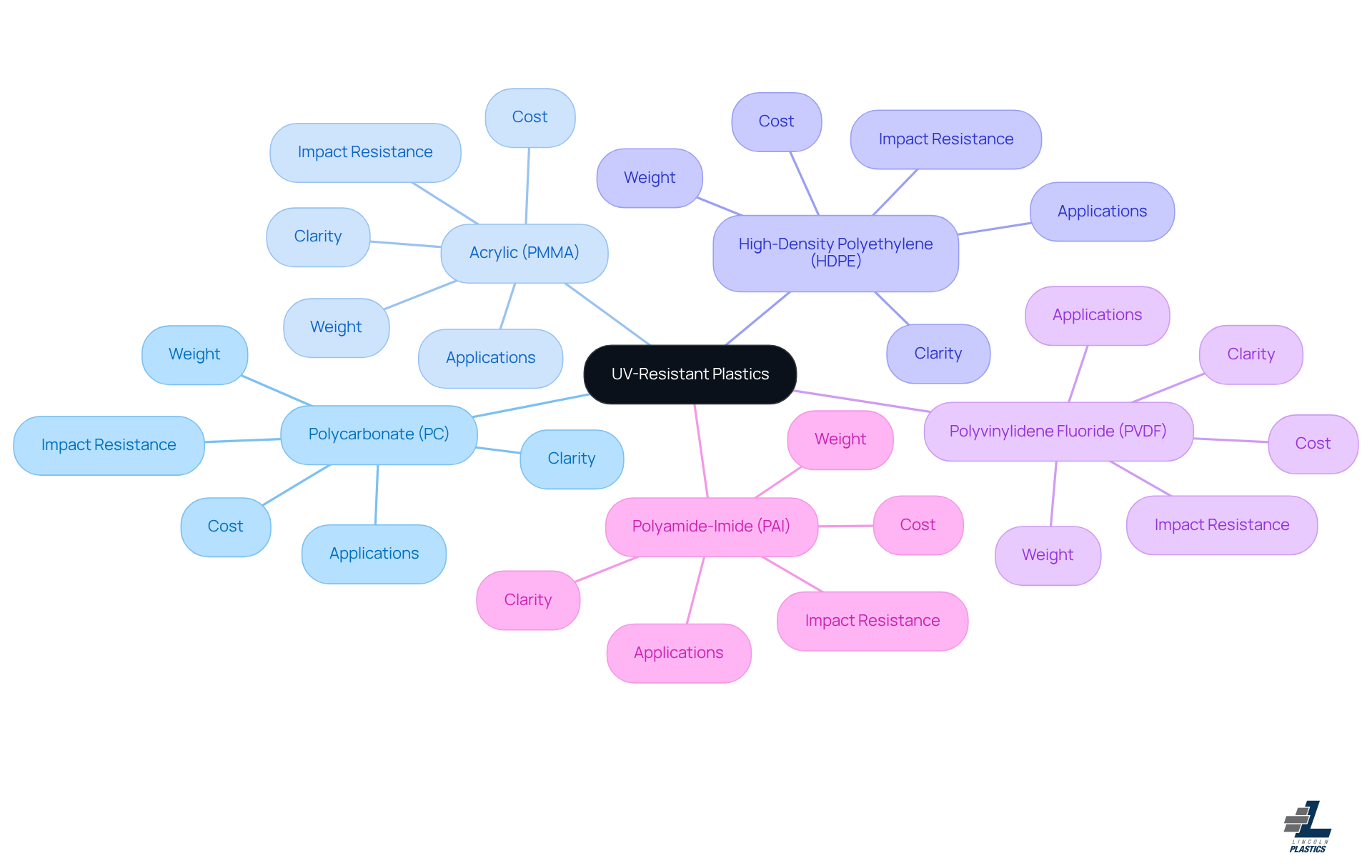
Comparing UV Resistance of Plastics: Key Insights for OEMs
Introduction
You know, understanding how ultraviolet (UV) radiation affects plastics is super important for manufacturers who want to boost product durability. With the right info, OEMs can pick materials that not only stand up to the sun's harsh rays but also keep their integrity over time. But here’s the kicker: as new additives and hybrid stabilizers pop up, it can feel overwhelming to navigate all the options out there to ensure top-notch performance.
So, what should you consider when checking out the UV resistance of different plastics? And how can this knowledge really shape the future of manufacturing? Let’s dive into this together!
Understanding UV Resistance in Plastics
Ultraviolet (UV) radiation can really mess with synthetic materials, right? You might notice things like discoloration, brittleness, and a drop in mechanical properties. So, how do we protect plastics from this? Well, one effective way is by adding UV stabilizers. These handy additives either absorb or reflect those harmful UV rays, keeping the polymer chains safe from degradation.
Now, understanding the specific wavelengths of UV radiation and how they affect different polymers is super important for OEMs. It helps them choose the right materials for applications that will be out in the sun. For example, polycarbonate and acrylic are known for their natural UV resistance, making them great choices for outdoor use.
But wait, there’s more! Additives like hindered amine light stabilizers (HALS) can really boost the longevity of materials against UV exposure. They help ensure that products stay effective over time. Research shows that HALS can regenerate continuously, offering longer-lasting protection compared to traditional antioxidants.
And let’s not forget about hybrid stabilizers! These combine HALS with antioxidants for dual-action protection against UV damage. Pretty neat, right? Statistics reveal that the lack of UV resistance of plastics can lead to significant degradation. Studies show that polyolefins like polypropylene and polyethylene are especially vulnerable to UV damage. This really highlights the importance of selecting the right materials and additives for durability in outdoor settings, especially regarding the UV resistance of plastics.
As experts point out, "UV stabilizers improve longevity in polymer-based roofing membranes and composite sidings." This just goes to show how essential they are in various applications. So, when you’re choosing materials, keep UV protection in mind - it makes a world of difference!

Comparative Analysis of UV-Resistant Plastics
When it comes to the uv resistance of plastics, you might be wondering which materials really stand out. Let’s break it down together:
-
Polycarbonate (PC): This one’s a favorite! Known for its high impact resistance and clarity, polycarbonate is a type of plastic that demonstrates excellent uv resistance of plastics. You’ll often find it in outdoor signage and safety gear. Just a heads up, though - it can scratch easily unless you give it a protective coating.
-
Acrylic (PMMA): If you need something lightweight and transparent, acrylic is your go-to. It offers excellent uv resistance of plastics and is lighter than glass, making it perfect for displays and protective barriers. Just keep in mind, it can be a bit more brittle than polycarbonate.
-
High-Density Polyethylene (HDPE): This material is a champion in terms of the uv resistance of plastics! You’ll see it used in outdoor furniture and containers. It’s strong and moisture-resistant, but it doesn’t quite have the clarity of acrylic or polycarbonate.
-
Polyvinylidene Fluoride (PVDF): Now, if you’re looking for something that can handle harsh environments, PVDF is recognized for its chemical durability and UV stability. It’s often used in architectural applications and coatings, but it can be on the pricier side.
-
Polyamide-Imide (PAI): This high-performance plastic is fantastic for its uv resistance of plastics and thermal stability, making it suitable for tough jobs in aerospace and automotive sectors. Just be aware that its cost might limit its use in less critical situations.
Each of these materials has its own unique traits that make them suitable for specific applications. When choosing, think about factors like cost, strength, and the environment they’ll be exposed to. So, what’s your next project? Let’s find the right material together!

Evaluating Performance and Durability in UV Exposure
When it comes to synthetic materials and their performance under UV exposure, it’s crucial to understand the UV resistance of plastics. Standardized testing methods, like ASTM G154, help us simulate sunlight exposure to see how materials degrade over time. Let’s dive into some key factors to keep in mind:
-
Color Stability: Ever noticed how some plastics fade in color when hit by UV light? For instance, acrylic does a great job of holding onto its color, while polycarbonate might start to yellow unless it’s treated with UV stabilizers.
-
Mechanical Properties: Prolonged UV exposure can really take a toll on materials, reducing their tensile strength and impact resistance. Testing shows that materials like HDPE do a better job of retaining their mechanical properties, making them a solid choice for outdoor use.
-
Surface Degradation: UV radiation can cause surface cracking and chalking, especially in materials that aren’t protected. Regular maintenance and protective coatings can really help mitigate these issues.
-
Longevity: Some plastics, especially those treated with HALS or UV absorbers, can last much longer outdoors. For example, UV-stabilized polycarbonate products can enjoy an extended lifespan of 5-10 years compared to their untreated counterparts.
So, why does all this matter? It is essential for OEMs to understand the UV resistance of plastics and how they perform. It ensures that their products can handle the demands of outdoor applications while keeping quality and safety standards in check. Ready to make informed choices for your projects?

Conclusion
Understanding UV resistance in plastics is super important for original equipment manufacturers (OEMs) who want their products to last longer and perform better outdoors. By choosing materials that naturally resist UV damage or adding effective stabilizers, manufacturers can really cut down on the negative effects of UV radiation. This way, their products stay durable and reliable over time.
Now, let’s talk about some plastics that are known for their UV resistance, like polycarbonate, acrylic, and high-density polyethylene (HDPE). Each of these materials has its own perks. For instance:
- Polycarbonate is clear and impact-resistant.
- Acrylic is lightweight.
- HDPE is strong.
Plus, using advanced additives like hindered amine light stabilizers (HALS) and hybrid stabilizers can boost the durability of these materials even more. It just goes to show how important it is to make informed choices when it comes to maintaining quality standards.
Ultimately, we can’t stress enough how crucial UV resistance is in plastics. As the demand for tough outdoor products keeps growing, OEMs really need to focus on materials that can handle environmental challenges. By staying updated on the latest trends and advancements in UV-resistant plastics, manufacturers can make smart choices that not only improve product performance but also keep customers happy. So, let’s embrace these insights! They’ll lead to stronger products and give you a competitive edge in the market.
Frequently Asked Questions
What is the impact of UV radiation on plastics?
UV radiation can cause discoloration, brittleness, and a decrease in mechanical properties in synthetic materials.
How can plastics be protected from UV radiation?
Plastics can be protected by adding UV stabilizers, which either absorb or reflect harmful UV rays, thereby preventing degradation of the polymer chains.
Why is understanding specific wavelengths of UV radiation important for OEMs?
Understanding specific wavelengths of UV radiation helps OEMs choose the right materials for applications exposed to sunlight, ensuring better performance and durability.
Which plastics are known for their natural UV resistance?
Polycarbonate and acrylic are known for their natural UV resistance, making them suitable for outdoor use.
What are hindered amine light stabilizers (HALS) and how do they help?
HALS are additives that enhance the longevity of materials against UV exposure by regenerating continuously, providing longer-lasting protection compared to traditional antioxidants.
What are hybrid stabilizers?
Hybrid stabilizers combine hindered amine light stabilizers (HALS) with antioxidants to offer dual-action protection against UV damage.
Which types of plastics are particularly vulnerable to UV damage?
Polyolefins like polypropylene and polyethylene are especially vulnerable to UV damage, highlighting the need for proper material selection and additives for outdoor durability.
What role do UV stabilizers play in construction materials?
UV stabilizers improve the longevity of polymer-based roofing membranes and composite sidings, demonstrating their essential role in various applications.
List of Sources
- Understanding UV Resistance in Plastics
- Advancements in UV Stabilization: Protecting Plastics for Longer Performance - 3V Sigma USA (https://3vsigmausa.com/advancements-in-uv-stabilization-longer-performance)
- A Comprehensive Outlook of Scope within Exterior Automotive Plastic Substrates and Its Coatings (https://mdpi.com/2079-6412/13/9/1569)
- 9 Essential Plastic Extrusion Process Steps for OEM Managers (https://lincoln-plastics.com/news-post/9-essential-plastic-extrusion-process-steps-for-oem-managers?dcc2137a_page=15)
- What is PVC Clear? Key Properties and Applications Explained (https://lincoln-plastics.com/news-post/what-is-pvc-clear-key-properties-and-applications-explained)
- uv stabilizer additives (https://vibrantcolortech.com/uv-stabilizer-additives)
- Comparative Analysis of UV-Resistant Plastics
- Differences Between Acrylic and Polycarbonate | Piedmont Plastics (https://piedmontplastics.com/blog/acrylic-vs-polycarbonate-understanding-the-differences?srsltid=AfmBOopNUOPWd1gAVWFI5niIk2zPwnhhxyWcEYzxhs5ydm6hwNPdcc6X)
- Polycarbonate vs. Acrylic: Material Differences and Comparisons (https://xometry.com/resources/materials/polycarbonate-vs-acrylic)
- These are the Five Best UV-Resistant Plastics on the Market Today (https://sybridge.com/top-uv-resistant-plastics)
- UV Stabilizer for Plastics Strategic Insights: Analysis 2025 and Forecasts 2033 (https://archivemarketresearch.com/reports/uv-stabilizer-for-plastics-662024)
- Evaluating UV-Resistant Plastic Options (https://protolabs.com/resources/design-tips/uv-resistant-plastics)


